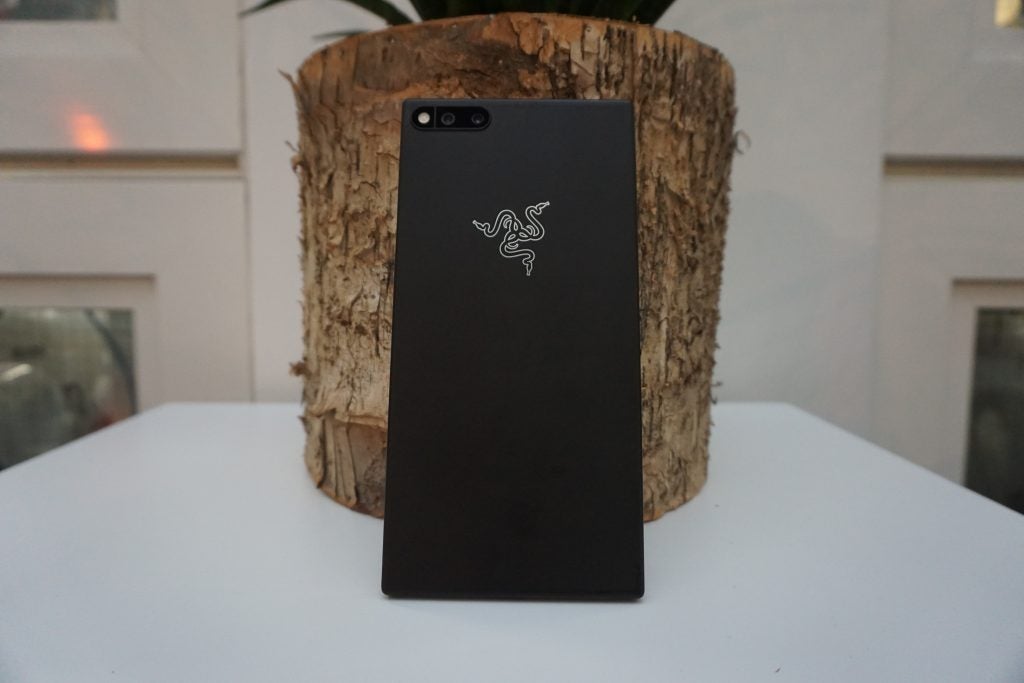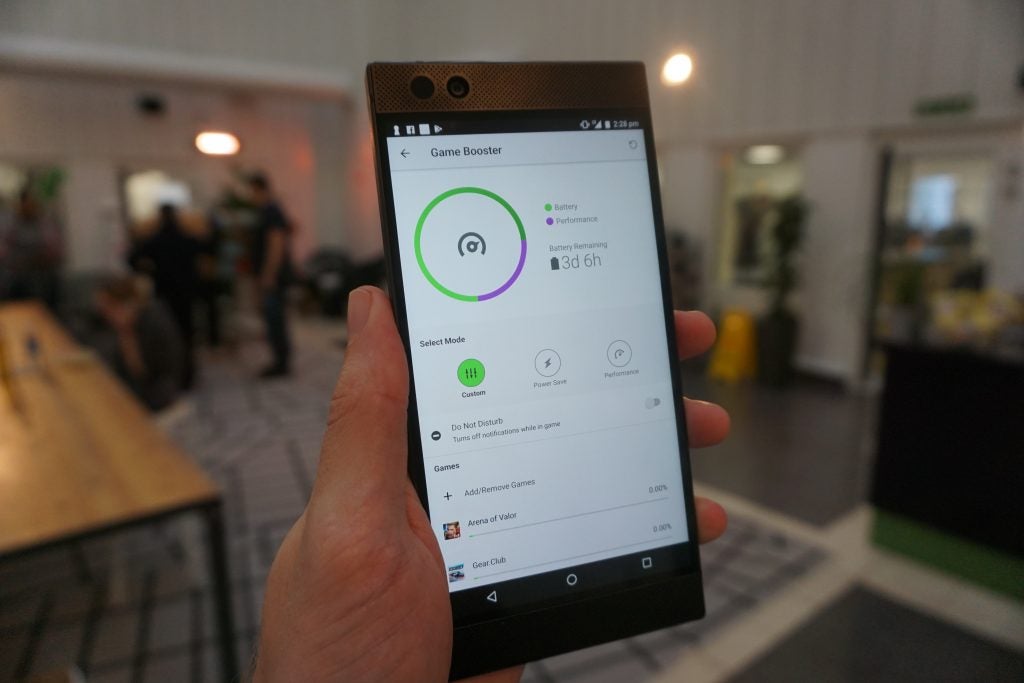Razer Phone Review
Razer Phone
Pwning n00bz since 2017

Sections
- Page 1 Razer Phone Review
- Page 2 Performance and Camera Review
- Page 3 Battery life and Verdict Review
Verdict
Pros
- Great performance and cooling
- Best-in-class speakers
- Superb screen
Cons
- Terrible camera
- No IP rating
Key Specifications
- Review Price: £699
- 5.72-inch 1440 x 2560 120Hz, Wide Color Gamut IGZO LCD w/ Corning Gorilla Glass 3
- 12-megapixel f/1.75 wide and 12-megapixel AF f/2.6 zoom dual-lens rear camera
- Qualcomm Snapdragon 835 CPU
- Upgraded to Android 8.1 Oreo
- Stereo front-facing speakers
- 4000 mAh lithium-ion battery
- 64GB storage (+ microSD)
- 8GB LPDDR4 RAM
What is the Razer Phone?
The Razer Phone is what it says it is: a phone made by Razer. But those in the know might be wondering why a company famous for making PC gaming peripherals and laptops turned its hand to phones. After all, with old-school heavyweights such as HTC and BlackBerry struggling to make an impact in an already saturated market, it doesn’t seem like an obvious move.
Following the Razer Phone’s release, ASUS announced the ROG Phone, which boasts a 90Hz display and a bunch of clever attachments, Honor introduced the Honor Play, which offers flagship specs at a low price, along with the company’s 4D Smart Shock rumble technology, and Xiaomi unveiled the powerful Black Shark.
Related: Best smartphones
Razer Phone – Design
If you’re a fan of Razer Blade laptops, you’ll probably love the Razer Phone’s design. The handset’s solid metal black chassis and pristinely-cut sides make it look a little like a shrunken-down Blade laptop. For regular fo,lk the design is a little retro, however.
Were it not for the Razer logo emblazoned on its back, I’d have guessed the phone was the concept for an unreleased Sony Xperia from 2015. The old-school vibe isn’t helped by its insanely hefty 197g weight, which combined with its sizeable dual front-facing speakers and 158.5 x 77.7 x 8mm dimensions, make it a pretty unwieldy device to use one-handed.
The phone’s slightly odd feeling in the hand isn’t helped by its atypical button placement. Razer has designed its phone to be primarily used in landscape, not portrait. According to its CEO, this is the position in which most gamers will spend their time holding it. Its power button sits in the middle of its right-hand side, while its volume up and down are found on its left.
This doesn’t sound terrible but combined with the phone’s large dimensions it meant I had to awkwardly adjust the phone’s position in my hand whenever I wanted to change the volume – which was particularly annoying when listening to music.
The only benefit to the power button’s placement, that I can decipher, is that using the built-in fingerprint scanner is a doddle. The button sits where your middle finger naturally falls and, once setup, this makes it quick and easy to power up and unlock the Razer Phone without multiple movements.

Outside of its slightly weird design, the Razer Phone has all the trimmings of a 2017 flagship smartphone. Apart from water-resistance, that is.
The metal frame is home to a USB-C charging port and, like many modern phones, is lacking a 3.5mm headphone jack. Curse you, Apple, for making my Sennheiser Momentum 2.0 useless during the morning commute without a dongle.
The Razer Phone does comes with a USB-C-to-headphone adapter with a powered DAC, like that of the HTC U11’s, which does go some way to compensate for the lack of a 3.5mm connector. But given the phone’s large dimensions, I can’t help but think Razer engineers could have found a way to include a jack anyway.
Build quality is excellent. After a fairly unceremonious accidental drop at the phone’s launch it emerged unscathed. I’m pretty certain this wouldn’t have been the case with a glass-backed handset such as the Galaxy S9 or iPhone XS.
Razer Phone – Screen
The Razer Phone’s screen is, without doubt, its most interesting feature. At first glance, it appears pretty bog standard. The 5.72-inch panel’s 1440 x 2560 resolution is sharp and clear, but no better than competing handsets such as the LG G7. Colours are well balanced to the naked eye out of the box, and blacks and whites were what I’d expect from an LCD – not AMOLED – panel.
Dig a little deeper and you’ll find it’s a very different beast indeed – one that might potentially provide an indication of what to expect from 2018’s next wave of flagships. The two biggest improvements over competing handsets are the inclusion of a variable refresh rate and new custom Ultramotion tech.
To non-techies, refresh rate refers to the number of times a display renders an image per second. Most phones have a locked refresh rate that’s capped at 60Hz (60 frames per second).

A variable refresh rate means the screen can change the number of times it renders an image per second, on the fly, depending on what it’s doing.
In the case of the Razer, this means the phone can optimise itself to run anywhere between 20-120Hz at any given moment. To non-PC gamers this won’t mean much – but, trust me, it’s actually a pretty cool feature that provides a variety of benefits.
The 120Hz max is a seriously impressive feature that, outside of the iPad Pro, is yet to appear in mobile devices. The higher refresh rate means the screen is significantly more responsive and smoother to use. By rendering more frames per second, there are fewer gaps between each new animation and image. The difference is particularly noticeable in reaction-focused games such as MOBAs.
The fact that it can lower its refresh rate for less demanding and slower tasks – such as basic browsing – should also help to conserve battery; the screen won’t be rendering new images quite so often.
Ultramotion is a nifty bit of tech that’s pretty similar to Nvidia’s G-Sync and AMD’s FreeSync. It syncronises the screen’s dynamic refresh rate with the GPU to stop it jumping ahead and pre-rendering images early, thus causing screen tears and anomalies appearing when playing games.
This feature may not sound that sexy but after a week with the Razer Phone, I’ve found every other handset I’ve tested since feels a little chuggy – particularly when gaming. I can’t help but hope other phone makers will start taking advantage of the tech.
Razer Phone – Software
The variable refresh rate’s appeal is further aided by the Razer Phone’s slightly customised software.
Out the box the Razer Phone ran Android Nougat but it’s since been upped to Android Oreo. The Nova Prime launcher running on top is one of the best around and, thanks to the lack of obvious bloatware, means the Razer Phone is fairly stable and generally great for everyday tasks. Even after months of use I’m yet to experience any serious application crashes or bugs.

Go into the settings and you’ll see that Razer has added a load of customisation options designed to help you take advantage of the improved display.
Some of these feel a little superfluous – the ability to change the phone’s default resolution to 720p or 1080p, and pick between a set 30GHz, 60Hz (default) or 90Hz refresh rate when out of apps, for example. Others, such as the Game Booster feature is pretty cool, though.
Related: Best Android phones
With the Game Booster you can create custom performance profiles on an app-by-app basis. This means you can boost the maximum FPS count on high performance, multiplayer, reaction-focused games; and lower it, saving battery as a result, for apps where it isn’t important.
The app also lets you control whether Ultramotion anti-aliasing is on. It’s a pretty neat feature that I expect a number of competitive mobile gamers will love. For everyone else, it will be an unobtrusive feature hidden away in the phone’s settings.
How we test phones
We test every mobile phone we review thoroughly. We use industry standard tests to compare features properly and we use the phone as our main device over the review period. We’ll always tell you what we find and we never, ever, accept money to review a product.


